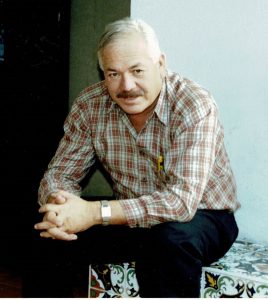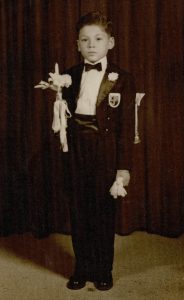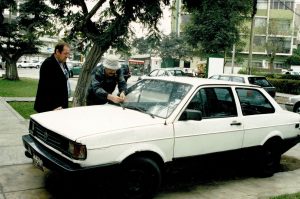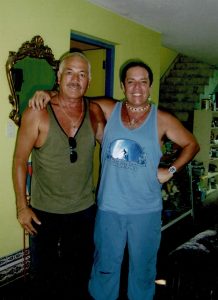A year ago, I lost my brother-in-law to COVID-19. He was one of millions now taken because of this insidious disease. But he is more than just a statistic. Like the millions of others who have suffered the same fate, he was somebody to so many. Miguel was a son, a brother, a husband, a father, a grandfather, an uncle, a cousin and a friend. Whilst so many have now turned their heads to the future, in a desperate attempt to put the past two years of the pandemic behind them, for others like my family, it is not so easy. We live with the images of his last days, in incredible pain and struggling for every breath. We live with the images of his funeral, where men in hazmat suits carried his plastic wrapped coffin and lowered it into the ground with his son his only mourner. This was not the end Miguel deserved, nor was it the end the millions of others deserved. There was no dignity in his death and we were powerless to change it. But we can remember him joyfully and ensure his life is remembered by future generations. This is Miguel’s story as remembered by his loving brother Marco.

Miguel’s birth on the 13th March 1949 was a cause for celebration in the our household. Ten months previously, our two-month-old brother Luis had died after being born with a throat abnormality. My grieving parents Urbano and Elmina prayed for the new baby’s safe arrival and with their prayers answered, they named their second son Miguel Angel (pronounced Aun-hill in Spanish).

My two-and-a-half-year-old sister Ana Isabel (Anita) was enamoured by her new brother and doted over him. Our family lived in an old house we called Berlin, after the name of street. The house had four bedrooms; Anita was in the front bedroom, me in the second bedroom with my mother and father, the third bedroom was occupied by Miguel and my other brother Ruben and the fourth bedroom for guests like our Neyra cousins who came to stay. The house was one of a set of five adjoining properties that each had a small front garden; we lived in number 4. A laneway connected each house along the front gardens. Miguel and Ruben played soccer in the dirt paddock opposite our house, long before I was able to join them. As he grew older, Miguel taught me to play soccer, basketball and paletas. Paletas was played with a bat and tennis ball, wherever and whenever we got the chance. The beach was a favourite spot or if we couldn’t be bothered going down the hill and back up again, the street would do. Berlin and later Juan Fanning where we moved to were busy streets so running up and down and dodging cars became part of our game. Summers were long and humid in Lima and I would often protest saying ‘I’m tired’ but Miguel would plead with me, ‘Come on! Get out of bed or you’re going to get fat!’ The suggestions didn’t end there. ‘Walk straight!’ ‘Put your tummy in!’ Miguel played the big brother role to its full entitlement. I was a more relaxed character so I would often just reply back, ‘So what!’ Miguel was no diplomat and would tell it straight, whether you liked it or not. But he also had a very cheeky personality and loved a good practical joke. When I was little Miguel would invite me to play hide and seek with him, but once hidden, he would sneak up behind to scare me, causing me to fall over and hurt myself. Like many older brothers, Miguel forgot his strength and the vulnerability of his younger siblings. But as I grew older, Miguel always kept an eye out for me. When Miguel became a store manager at Scala, he got me a job as a checkout supervisor. Years later, when I was at a loose end with work again, Miguel used his basketball friends who had connections with the Merchant Navy officials to land me an interview. Months later I would sail away on an adventure that would see me migrate to Australia, an adventure orchestrated by a big brother who desperately wanted me to succeed in life.
Miguel was a party goer who had lots of friends. A bit of a wild child, he would gather with his 15-16 year old friends at the corner shop and drink. He would stay out with friends until late at night, coming home by taxi and upsetting my parents. Once as a teenager he decided that the taxi he had access to at home was a better proposition than paying for one, so he ‘borrowed’ our father’s light green Packard that he used as a taxi to support our family. Miguel showed up about 5pm after many hours out and about in it, meaning our father missed a day’s work. And whilst our father didn’t flog him for his stupidity, Papito did lose his temper and break a few things and Miguel never took the car again. In later years Miguel would own an avocado-green Austin Mini Minor that he took us siblings out in. One time the car broke down on the mountainside on a bend with me, Anita and Fabiola, Miguel’s wife in it. Anita freaked out that we were going to get hit by another car, but cool as a cucumber, Miguel just laughed it off.

In between partying, Miguel spent his high school years immersed in the world of competitive basketball. In about 1965, he travelled to Mexico City, Miami and Santiago with his high school team. At 6ft tall, Miguel was a natural player and the team was quite successful. After leaving school, Miguel completed a business studies course at university and landed a job as a bank teller. Then Miguel met Fabiola, the woman he would spend the rest of his life with. In fact, over 50 years. They married in 1969 and a year later their first son Miguelito was born. A handsome little boy, he brought joy to the whole Neyra household and everyone dotted on him. Miguel and Fabiola were young parents, just 21 years old. Five years later their second son Julio Cesar (Julito) came along. Julito was a healthy thriving little toddler until he contracted meningitis which severely affected his brain. He spent the rest of his life in the care of his devoted parents. Miguel and Fabiola never left his side, until Julito left earthside for heaven in 2016, aged 41.
After his stints as a store manager, bank teller and a medical sales representative, Miguel completed a short course in real estate and began selling houses with his friend Luis Alvarez. A partnership that was to last 30 years, Luis and Miguel sold properties from Chorrillos to San Isidro, to Miraflores and La Molina in Lima. With his real estate contacts, Miguel was able to purchase a block of land near the beach at Chorrillos in the late 1980s. From here his friends and family helped build a house for Miguel, Fabiola, Miguelito and Julito. As the house grew so did the parties, with Miguel and Fabiola superb hosts. Miguel was now able to work his own hours and enjoy some freedom to pursue his interests. Miguel’s passion was for music. He spent many nights at his favourite peña criollas, or folk music venues. He also loved to dance salsa and sing along to his favourite songs. Miguel was a born entertainer who could captivate his audience with his songs and his storytelling. I would often go along with him to these peñas when I returned home to Lima from Australia, reliving my youth and enjoying a shared love of music with my brother.
I saw my brother only a few times between 1984 when I left Peru on that merchant ship and 2016, my last visit home. But we talked endlessly on the phone and when technology advanced with the invention of ‘Facetime’ we were able to have virtual face to face chats. We could talk for hours, reminiscing about our youth, friends we knew and about current affairs. This became especially important when in 2012, Miguel was diagnosed with throat cancer. He was by then 63 years old and 50 years of the good life had finally caught up with him. The cancer in his oesophagus was aggressive and he endured many rounds of chemotherapy and radiotherapy which weakened him to the point where we all feared he wouldn’t make it. The odds were stacked against him with a low survival rate for those with this type of cancer. But survive he did and he bounced back with gusto to resume his party lifestyle.
Then in early 2021, some nine years after the first diagnosis, came the news that the cancer had returned. Appointments were made and a treatment plan arranged and in the meantime, with the COVID vaccines just being released, Miguel and Fabiola both took their first shot. But it was too late, for they had already been exposed to the virus. With an already compromised airway from the prior radiation treatment, Miguel was at high risk of complications. As the days wore on, both Miguel and Fabiola’s condition’s deteriorated and they required oxygen and 24 hour nursing care at home. Then it got so bad that they were admitted to hospital, into beds that had been desperately sought by their son all the way from his home in Los Angeles. Miguelito flew to Lima and was able to spend a few precious hours at the hospital with his parents. Then Miguel’s oxygen levels dropped dangerously low. All the while we were receiving updates and each time the news was worse. I prayed I would not lose another brother but lose him I did. Miguel died on the 23rd May 2021 from COVID-19. He was 72 years old. Today, and every day, I remember him for the amazing brother he was. God bless him.

Hace un año, perdí a mi cuñado por el COVID-19. Él era uno de los millones ahora afectados a causa de esta insidiosa enfermedad. Pero él es más que una simple estadística. Como los millones de otros que han sufrido el mismo destino, él era alguien para muchos. Miguel fue hijo, hermano, esposo, padre, abuelo, tío, primo y amigo. Si bien muchos ahora han vuelto la cabeza hacia el futuro, en un intento desesperado por dejar atrás los últimos dos años de la pandemia, para otros como mi familia, no es tan fácil. Vivimos con las imágenes de sus últimos días, con un dolor increíble y luchando por cada respiración. Vivimos con la imagen de su funeral, donde hombres vestidos con trajes protectores cargaron su ataúd envuelto en plástico y lo bajaron al suelo con su hijo, su único doliente. Este no era el final que Miguel merecía, ni era el final que merecían millones de personas. No hubo dignidad en su muerte y éramos impotentes para cambiarlo. Pero podemos recordarlo con alegría y asegurarnos de que su vida sea recordada por las generaciones futuras. Esta es la historia de Miguel tal como la recuerda su amado hermano Marco.
El nacimiento de Miguel el 13 de marzo de 1949 fue motivo de celebración en nuestra casa. Diez meses antes, nuestro hermano Luis, de dos meses, había muerto después de nacer con una anomalía en la garganta. Mis afligidos padres Urbano y Elmina oraron por la llegada segura del nuevo bebé y con sus oraciones respondidas, llamaron a su segundo hijo Miguel Angel (pronunciado Aun-hill en español).
Mi hermana Ana Isabel (Anita), de dos años y medio, estaba muy feliz de su nuevo hermano y lo adoraba. Nuestra familia vivía en una casa antigua a la que llamamos Berlín, por el nombre de la calle. La casa tenía cuatro dormitorios; Anita estaba en la recámara del frente, yo en la segunda recámara con mi mamá y mi papá, la tercera recámara la ocupaban Miguel y mi otro hermano Rubén y la cuarta recámara para invitados como nuestras primas Neyra que vinieron para quedarse. La casa formaba parte de un conjunto de cinco propiedades contiguas que tenían cada una un pequeño jardín delantero; vivíamos en el número 4. Un callejón conectaba cada casa a lo largo de los jardines delanteros. Miguel y Rubén jugaban fútbol en el potrero de tierra frente a nuestra casa, mucho antes de que pudiera unirme a ellos. A medida que crecía, Miguel me enseñó a jugar fútbol, baloncesto y paletas. Paletas se jugaba con bate y pelota de tenis, donde y cuando teníamos la oportunidad. La playa era un lugar favorito o, si no podíamos molestarnos en bajar la colina y volver a subir, la calle funcionaría. Berlín y más tarde Juan Fanning, a donde nos mudamos, eran calles concurridas, por lo que correr de un lado a otro y esquivar autos se convirtió en parte de nuestro juego. Los veranos eran largos y húmedos en Lima y yo solía protestar diciendo ‘estoy cansada’, pero Miguel me suplicaba: ‘¡Vamos! ¡Sal de la cama o vas a engordar! Las sugerencias no terminaron ahí. ‘¡Camina derecho!’ ‘¡Mete la barriga!’ Miguel interpretó el papel de hermano mayor en todo su derecho. Yo era un personaje más relajado, por lo que a menudo simplemente respondía: ‘¡Y qué!’. Miguel no era un diplomático y lo decía sin rodeos, te gustara o no. Pero también tenía una personalidad muy descarada y amaba las buenas bromas pesadas. Cuando era pequeño Miguel me invitaba a jugar a las escondidas con él, pero una vez escondido, se acercaba sigilosamente por detrás para asustarme, haciendo que me cayera y me lastimara. Como muchos hermanos mayores, Miguel olvidó su fuerza y la vulnerabilidad de sus hermanos menores. Pero a medida que fui creciendo, Miguel siempre estuvo pendiente de mí. Cuando Miguel se convirtió en gerente de tienda en Scala, me consiguió un trabajo como supervisor de caja. Años más tarde, cuando estaba otra vez sin trabajo, Miguel usó a sus amigos del baloncesto que tenían conexiones con los oficiales de la Marina Mercante para conseguirme una entrevista. Meses después me embarcaría en una aventura que me llevaría a migrar a Australia, una aventura orquestada por un hermano mayor que deseaba desesperadamente que tuviera éxito en la vida.
Miguel era un fiestero que tenía muchos amigos. Un niño un poco salvaje, se reunía con sus amigos de 15-16 años en la tienda de la esquina y bebía. Se quedaba con amigos hasta altas horas de la noche, volvía a casa en taxi y molestaba a mis padres. Una vez, cuando era adolescente, decidió que el taxi al que tenía acceso en casa era una mejor propuesta que pagar por uno, por lo que “tomó prestado” el Packard verde claro de nuestro padre que usó como taxi para mantener a nuestra familia. Miguel apareció alrededor de las 5 p. m. después de muchas horas fuera de casa, lo que significa que nuestro padre perdió un día de trabajo. Y si bien nuestro padre no lo azotó por su estupidez, Papito sí perdió los estribos y rompió algunas cosas y Miguel nunca volvió a tomar el auto. En años posteriores, Miguel sería dueño de un Austin Mini Minor verde palta en el que nos llevaba a los hermanos. Una vez el auto se descompuso en la ladera de la montaña en una curva conmigo, Anita y Fabiola, la esposa de Miguel, adentro del carro. Anita se asustó que nos ibamos a estrellar con otro auto, pero Miguel se mataba de la risa!
Entre fiestas, Miguel pasó sus años de escuela secundaria inmerso en el mundo del baloncesto competitivo. Aproximadamente en 1965, viajó a la Ciudad de México, Miami y Santiago con su equipo de secundaria. Con 6 pies de altura, Miguel era un jugador natural y el equipo tuvo bastante éxito. Después de dejar la escuela, Miguel completó un curso de estudios comerciales en la universidad y consiguió un trabajo como cajero de banco. Entonces Miguel conoció a Fabiola, la mujer con la que pasaría el resto de su vida. De hecho, más de 50 años. Se casaron en 1969 y un año después nació su primer hijo Miguelito. Un niño hermoso, trajo alegría a toda la casa de Neyra y todos se volcaron con él. Miguel y Fabiola eran padres jóvenes, de tan solo 21 años. Cinco años después nació su segundo hijo, Julio César (Julito). Julito era un niño pequeño sano y próspero hasta que contrajo meningitis que afectó severamente su cerebro. Pasó el resto de su vida al cuidado de sus devotos padres. Miguel y Fabiola nunca se apartaron de su lado, hasta que Julito se fue de la tierra al cielo en 2016, a los 41 años.
Después de sus períodos como gerente de tienda, cajero de banco y representante de ventas médicas, Miguel completó un curso corto en bienes raíces y comenzó a vender casas con su amigo Luis Alvarez. Una sociedad que iba a durar 30 años, Luis y Miguel vendieron propiedades desde Chorrillos hasta San Isidro, hasta Miraflores y La Molina en Lima. Con sus contactos inmobiliarios, Miguel pudo comprar un terreno cerca de la playa de Chorrillos a fines de la década de 1980. Desde aquí sus amigos y familiares ayudaron a construir una casa para Miguel, Fabiola, Miguelito y Julito. A medida que la casa crecía, también lo hacían las fiestas, con Miguel y Fabiola como magníficos anfitriones. Miguel ahora podía trabajar su propio horario y disfrutar de cierta libertad para perseguir sus intereses. La pasión de Miguel era la música. Pasó muchas noches en sus peñas criollas favoritas o lugares de música folclórica. También le encantaba bailar salsa y cantar sus canciones favoritas. Miguel era un animador nato que podía cautivar a su audiencia con sus canciones y su narración. Muchas veces lo acompañaba a estas peñas cuando regresaba a Lima desde Australia, reviviendo mi juventud y disfrutando de un amor por la música compartido con mi hermano.
Vi a mi hermano solo unas pocas veces entre 1984 cuando salí de Perú en ese barco mercante y 2016, mi última visita a casa. Pero hablábamos sin parar por teléfono y cuando la tecnología avanzó con la invención de ‘Facetime’ pudimos tener chats virtuales cara a cara. Podríamos hablar durante horas, recordando nuestra juventud, amigos que conocimos y sobre temas de actualidad. Esto se volvió especialmente importante cuando en 2012, a Miguel le diagnosticaron cáncer de garganta. Tenía entonces 63 años y 50 años de buena vida finalmente lo habían alcanzado. El cáncer en su esófago era agresivo y soportó muchas rondas de quimioterapia y radioterapia que lo debilitaron hasta el punto en que todos temíamos que no lo lograría. Las probabilidades estaban en su contra con una baja tasa de supervivencia para las personas con este tipo de cáncer. Pero sobrevivió y se recuperó con entusiasmo para reanudar su estilo de vida fiestero.
Luego, a principios de 2021, unos nueve años después del primer diagnóstico, llegó la noticia de que el cáncer había regresado. Se concertaron citas y se organizó un plan de tratamiento y, mientras tanto, con las vacunas COVID recién lanzadas, Miguel y Fabiola recibieron su primera inyección. Pero ya era demasiado tarde, porque ya habían estado expuestos al virus. Con una vía aérea ya comprometida por el tratamiento de radiación anterior, Miguel tenía un alto riesgo de complicaciones. Con el paso de los días, el estado de Miguel y Fabiola empeoró y requirieron oxígeno y cuidados de enfermería las 24 horas en el hogar. Luego se puso tan mal que fueron admitidos en el hospital, en camas que su hijo había buscado desesperadamente desde su casa en Los Ángeles. Miguelito voló a Lima y pudo pasar unas horas preciosas en el hospital con sus padres. Luego, los niveles de oxígeno de Miguel cayeron peligrosamente bajos. Todo el tiempo estábamos recibiendo actualizaciones y cada vez las noticias eran peores. Recé para no perder a otro hermano, pero lo perdí. Miguel falleció el 23 de mayo de 2021 de COVID-19. Tenía 72 años. Hoy, y todos los días, lo recuerdo por el increíble hermano que fue. Dios lo bendiga.
